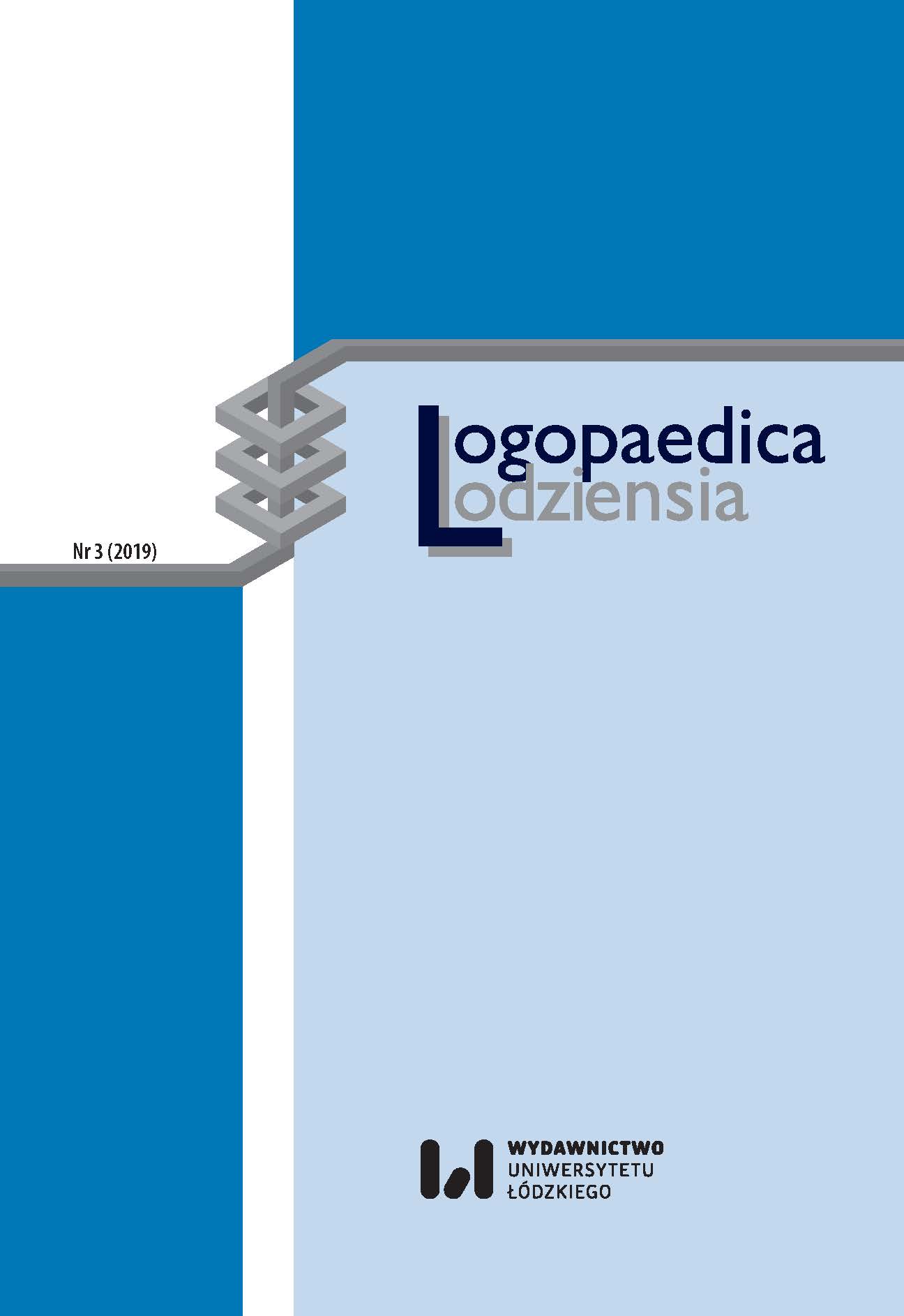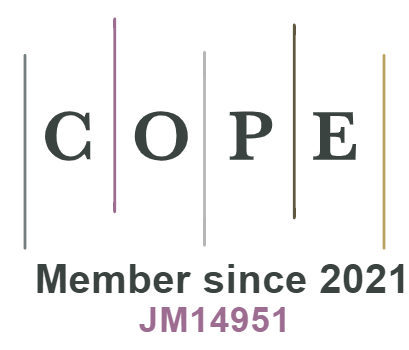Jeden czy dwa języki w komunikacji z dziećmi ze spektrum zaburzeń autystycznych?
DOI:
https://doi.org/10.18778/2544-7238.03.08Słowa kluczowe:
autyzm, dwujęzyczność, edukacja specjalna, logopeda, mniejszość narodowaAbstrakt
Najnowsze badania mające na celu porównanie poziomu rozwoju werbalnego i niewerbalnego dzieci w normie rozwojowej i dzieci ze spektrum autyzmu nie ujawniły różnic w możliwości nabywania języka angielskiego przy zachowaniu języka ojczystego jako L1. Badania prowadzone wśród rodziców dzieci ze zdiagnozowanym autyzmem sugerują, że logopedzi nie powinni proponować nauczania tylko w języku angielskim (w nim prowadzona jest większość programów terapeutycznych) czy tylko ojczystym. Zadaniem logopedów i innych specjalistów jest zaplanowanie terapii w taki sposób, aby zachować szacunek dla kultury i języka swoich pacjentów. Wybór języka to złożona kwestia, uzależniona od struktury rodziny, wymagań sytuacyjnych, różnic w biegłości językowej oraz wielu innych ograniczeń i możliwości życia rodzinnego. To, w którym języku rodzice zdecydują się rozmawiać z dziećmi, powinno wynikać z ich osobistych decyzji. Decyzje te nie są ani dobre, ani złe, są jednak często podejmowane błędnie z powodu mylnego przekonania na temat negatywnego wpływu nauki dwóch języków na dzieci ze spektrum zaburzeń autystycznych. Logopedzi odgrywają ważną rolę w promowaniu wiedzy na ten temat – dzięki ich działalności rodziny mogą swobodnie korzystać z języka, który dobrze wpływa na samopoczucie i cele rodzin (utrzymanie języka dziedziczonego).
Pobrania
Bibliografia
Baker C., Wright W. E., 2017, Foundations of bilingual education and bilingualism, 6th ed., Bristol: Multilingual Matters.
Google Scholar
DOI: https://doi.org/10.1007/978-3-319-02258-1_2
Bauer S.C., Winegar J., Waxman S., 2016, How cultural differences affect autism diagnoses, Scientific American. Guest blog, https://news.northwestern.edu/stories/2016/04/opinion-scientificamerican-autism/ (accessed: 15.11.2018).
Google Scholar
Becerra T. A., Ehrenstein O. S. von, Heck J. E., Olsen J., Arah O. E., Jeste S. S., Rodriguez M., Ritz B., 2014, Autism spectrum disorders and race, ethnic, and nativity: A population‑based study, “Pediatrics”, vol. 134(1), pp. e63–e71, http://doi.org/10.1542/peds.2013-3928
Google Scholar
DOI: https://doi.org/10.1542/peds.2013-3928
Bialystok E., 2001, Bilingualism in development: Language, literacy and cognition, Cambridge: Cambridge University Press.
Google Scholar
DOI: https://doi.org/10.1017/CBO9780511605963
Center for Disease Control and Prevention, 2018, Autism Spectrum Disorder, https://www/cdc.gov/ncbddd/autism/data.html (accessed: 15.11.2018).
Google Scholar
Collier V. P., Thomas W. P., 2004, The astounding effectiveness of dual language education for all, “NABE Journal of Research and Practice”, vol. 2(1), pp. 1–20.
Google Scholar
Drysdale H., Meer L. van der, Kagohara D., 2015, Children with autism spectrum disorder from bilingual families: A systematic review, “Review Journal of Autism and Developmental Disorders”, vol. 2(1), pp. 26–38.
Google Scholar
DOI: https://doi.org/10.1007/s40489-014-0032-7
Ennis‑Cole D., Durodoye B. A., Harris H. L., 2013, The impact of culture on autism diagnosis and treatment: Considerations for counselors and other professionals, “The Family Journal”, vol. 21(3), pp. 279–287.
Google Scholar
DOI: https://doi.org/10.1177/1066480713476834
Fishman J. A., 2006, English only: Its ghosts, myths and dangers, [in:] N. H. Hornberger (ed.), Language loyalty, language planning and language revitalization: Recent writings and reflections from Joshua A. Fishman, Clevedon: Multilingual Matters, pp. 179–194.
Google Scholar
Genesee F., 1983, Bilingual education of majority‑language children: The Immersion experiments in review, “Applied Psycholinguistics”, vol. 4(1), pp. 1–46.
Google Scholar
DOI: https://doi.org/10.1017/S0142716400001739
Grosjean F., 2010, Bilingual life and reality, Cambridge: Harvard University Press.
Google Scholar
DOI: https://doi.org/10.4159/9780674056459
Hambly C., Fombonne E., 2012, The impact of bilingual environments on language development in children with autism spectrum disorders, “Journal of Autism and Developmental Disorders”, vol. 42(7), pp. 1342–1352, http://doi.org/10.1007/s10803-011-1365-z
Google Scholar
DOI: https://doi.org/10.1007/s10803-011-1365-z
Kay‑Raining Bird E., Lamond E., Holden J., 2012, Survey of bilingualism in autism spectrum disorders, “International Journal of Language & Communication Disorders”, no. 47, pp. 54–64, http://doi.org/10.1111/j1460-6984.2011.00071.x
Google Scholar
DOI: https://doi.org/10.1111/j.1460-6984.2011.00071.x
Kremer‑Sadlik T., 2004, To be or not to be bilingual: Autistic children from multilingual families, Unpublished paper presented at The Fourth International Symposium on Bilingualism, Tempe.
Google Scholar
Langdon H. W., Saenz T. I., 2016, Working with interpreters and translators. A guide for speech‑language pathologists and audiologists, San Diego: Plural Publishing.
Google Scholar
Lindholm‑Leary K. J., Howard E. R., 2008, Language development and academic achievement in two‑way immersion programs, [in:] T. W. Fortune, D. J. Tedick (eds.), Pathways to multilingualism: Evolving perspectives od immersion education, Oxford: Blackwell, pp. 177–200.
Google Scholar
DOI: https://doi.org/10.21832/9781847690371-012
Marian V., Shook A., Schroeder S. R., 2013, Bilingual two‑way immersion programs benefit academic achievement, “Bilingual Research Journal”, vol. 36(2), pp. 167–186.
Google Scholar
DOI: https://doi.org/10.1080/15235882.2013.818075
Nevison C., Blaxill M., Zahorodny W., 2018, California autism prevalence trends from 1931 to 2014 and comparison to national ASD data from IDEA and ADDM, “Journal of Autism and Developmental Disorders”, vol. 48(12), pp. 4103–4117.
Google Scholar
DOI: https://doi.org/10.1007/s10803-018-3670-2
Ohashi J. K., Mirenda P., Marinova‑Todd S., Hambly C., Fombonne E., Szatmari P., Thompson A., 2012, Comparing early language development in monolingual‑ and bilingual‑exposed young children with autism spectrum disorders, “Research in Autism Spectrum Disorders”, no. 6, pp. 890–897.
Google Scholar
DOI: https://doi.org/10.1016/j.rasd.2011.12.002
Paradis J., Genesee F., Crago M., 2011, Dual language development and disorders: A handbook on bilingualism and second language, Baltimore: Brookes Publishing.
Google Scholar
Petersen J. M., Marinova‑Todd S., Mirenda P., 2012, Brief report: An exploratory study of lexical skills in bilingual children with autism spectrum disorder, “Journal of Autism and Developmental Disorders”, vol. 42(7), pp. 1499–1503, http://doi.org/10.1007/s1080-011-1366-y
Google Scholar
DOI: https://doi.org/10.1007/s10803-011-1366-y
Ramaga P., 1992, The basis of minority identity, “Human Rights Quarterly”, vol. 14(3), pp. 409–428.
Google Scholar
DOI: https://doi.org/10.2307/762373
Reetzke R., Zou X., Sheng L., Katsos N., 2015, Communicative development in bilingually exposed Chinese children with autism spectrum disorders, “Journal of Speech, Language, and Hearing Research”, vol. 58(1), pp. 813–825, http://doi.org/10.1044/2015_JSLHR‑L‑13-0258
Google Scholar
DOI: https://doi.org/10.1044/2015_JSLHR-L-13-0258
Schwartz M., Verschik A. (eds.), 2013, Successful family language policy: Parents, children and educators in interaction, vol. 7, Berlin: Springer.
Google Scholar
DOI: https://doi.org/10.1007/978-94-007-7753-8_1
Seung H., Siddiqi S., Elder J. H., 2006, Intervention outcomes of a bilingual child with autism, “Journal of Medical Speech‑Language Pathology”, vol. 14(1), pp. 53–63.
Google Scholar
Seung H. K., 2017, How to handle bilingual children with autism spectrum disorder, “CSHA Magazine”, vol. 46(3), pp. 10–13.
Google Scholar
Sugarman J., Geary C., 2018, English Learners in California: Demographics, outcomes, and state accountability policies, Washington: Migration Policy Institute.
Google Scholar
U. S. Census Bureau, 2017, Percent of people 5 years and over who speak a language other than English at home: United States and Puerto Rico Universe: Populations 5 years and over 2016 American Community Survey 1‑year estimates, https://cdn.cnsnews.com/attachments/census‑other_than_english.pdf (accessed: 15.11.2018).
Google Scholar
Valicenti‑McDermott M., Tarshis N., Schouls M., Galdston M., Hottinger K., Seijo R., Shinnar S., 2013, Language differences between monolingual English and bilingual English‑Spanish young children with autism spectrum disorders, “Journal of Child Neurology”, vol. 28(7), pp. 945–948, http://doi.org/10.1177/0883073812453204
Google Scholar
DOI: https://doi.org/10.1177/0883073812453204
Wharton R. H., Levine K., Miller E., Breslau J., Greenspan S. I., 2000, Children with Special Needs in Bilingual Families: A Developmental Approach to Language Recommendations, [in:] S. I. Greenspan, S. Wieder (eds.), The Interdisciplinary Council on Developmental and Learning Disorders Clinical Practice Guidelines, Bethesda: ICDL, pp. 141–151.
Google Scholar
Yu B., 2013, Issues in bilingualism and heritage language maintenance: Perspectives of minority‑language mothers of children with autism spectrum disorders, “American Journal of Speech‑Language Pathology”, vol. 22, issue 1, pp. 10–24.
Google Scholar
DOI: https://doi.org/10.1044/1058-0360(2012/10-0078)
Yu B., 2016, Bilingualism as conceptualized and bilingualism as lived: A critical examination of the monolingual socialization of a child with autism in a bilingual family, “Journal of Autism and Developmental Disorders”, vol. 46, issue 2, pp. 424–435.
Google Scholar
DOI: https://doi.org/10.1007/s10803-015-2625-0
Yu B., Hsia S., 2018, Inclusion of heritage language learners on the autism spectrum: Lessons from second‐generation parents, “International Journal of Applied Linguistics”, https://doi.org/10.1111/ijal.12233
Google Scholar
DOI: https://doi.org/10.1111/ijal.12233
Pobrania
Opublikowane
Jak cytować
Numer
Dział
Licencja

Utwór dostępny jest na licencji Creative Commons Uznanie autorstwa – Użycie niekomercyjne – Bez utworów zależnych 4.0 Międzynarodowe.












